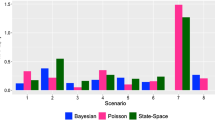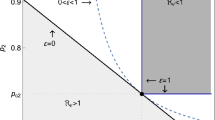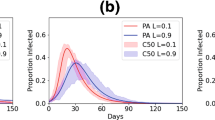Abstract
Almost all models used in analysis of infectious disease outbreaks contain some notion of population size, usually taken as the census population size of the community in question. In many settings, however, the census population is not equivalent to the population likely to be exposed, for example if there are population structures, outbreak controls or other heterogeneities. Although these factors may be taken into account in the model: adding compartments to a compartmental model, variable mixing rates and so on, this makes fitting more challenging, especially if the population complexities are not fully known. In this work we consider the concept of effective population size in outbreak modelling, which we define as the size of the population involved in an outbreak, as an alternative to use of more complex models. Effective population size is an important quantity in genetics for estimation of genetic diversity loss in populations, but it has not been widely applied in epidemiology. Through simulation studies and application to data from outbreaks of COVID-19 in China, we find that simple SIR models with effective population size can provide a good fit to data which are not themselves simple or SIR.







Similar content being viewed by others
Data availability
Data and relevant code for this research work are available on GitHub at https://github.com/Yemaye/effectivepopulation (Yerlanov 2021).
References
Anderson RM, May RM (1992) Infectious diseases of humans: dynamics and control. Oxford University Press, Oxford
Anderson SC, Edwards AM, Yerlanov M et al (2020) Quantifying the impact of COVID-19 control measures using a Bayesian model of physical distancing. PLoS Comput Biol. https://doi.org/10.1371/journal.pcbi.1008274
Bezanson J, Edelman A, Karpinski S et al (2017) Julia: a fresh approach to numerical computing. SIAM Rev 59(1):65–98. https://doi.org/10.1137/141000671
Brauer F (2008) Compartmental models in epidemiology. Math Epidemiol 1945:19–79. https://doi.org/10.1007/978-3-540-78911-6_2
Brauer F (2017) Mathematical epidemiology: past, present, and future. Infect Dis Model 2(2):113–127. https://doi.org/10.1016/j.idm.2017.02.001
Caley P, Philp DJ, McCracken K (2008) Quantifying social distancing arising from pandemic influenza. J R Soc Interface 5(23):631–639. https://doi.org/10.1098/rsif.2007.1197
Charlesworth B (2009) Effective population size and patterns of molecular evolution and variation. Nat Rev Genet 10(3):195–205. https://doi.org/10.1038/nrg2526
China Data Lab, Harvard Dataverse (2020) China COVID-19 daily cases with basemap. https://doi.org/10.7910/DVN/MR5IJN
Cope RC, Ross JV, Chilver M et al (2018) Characterising seasonal influenza epidemiology using primary care surveillance data. PLoS Comput Biol 14(8):e1006377. https://doi.org/10.1371/journal.pcbi.1006377
Diekmann O, Heesterbeek J, Roberts MG (2010) The construction of next-generation matrices for compartmental epidemic models. J R Soc Interface 7(47):873–885. https://doi.org/10.1098/rsif.2009.0386
Gibbs H, Liu Y, Pearson CA et al (2020) Changing travel patterns in China during the early stages of the COVID-19 pandemic. Nat Commun 11(1):5012. https://doi.org/10.1038/s41467-020-18783-0
Hu T, Guan WW, Zhu X et al (2020) Building an open resources repository for COVID-19 research. Data Inf Manag 4(3):130–147. https://doi.org/10.2478/dim-2020-0012
Husemann M, Zachos F, Paxton R et al (2016) Effective population size in ecology and evolution. Heredity 117(4):191–192. https://doi.org/10.1038/hdy.2016.75
Keeling MJ, Rohani P (2011) Modeling infectious diseases in humans and animals. Princeton University Press, Princeton
KhudaBukhsh WR, Choi B, Kenah E et al (2020) Survival dynamical systems: individual-level survival analysis from population-level epidemic models. Interface Focus 10(1):20190048. https://doi.org/10.1098/rsfs.2019.0048
Kliman R, Sheehy B, Schultz J (2008) Genetic drift and effective population size. Nat Educ 1(3):3. https://doi.org/10.1093/genetics/98.3.625
Kucharski AJ, Russell TW, Diamond C et al (2020) Early dynamics of transmission and control of COVID-19: a mathematical modelling study. Lancet Infect Dis 20(5):553–558. https://doi.org/10.1016/S1473-3099(20)30144-4
Lai S, Ruktanonchai NW, Zhou L et al (2020) Effect of non-pharmaceutical interventions to contain COVID-19 in China. Nature 585(7825):410–413. https://doi.org/10.1038/s41586-020-2293-x
Liu Y, Gayle AA, Wilder-Smith A et al (2020) The reproductive number of COVID-19 is higher compared to SARS coronavirus. J Travel Med. https://doi.org/10.1093/jtm/taaa021
R Core Team (2017) R: a language and environment for statistical computing. R Foundation for Statistical Computing, Vienna https://www.R-project.org/
Stewart GW (1980) The efficient generation of random orthogonal matrices with an application to condition estimators. SIAM J Numer Anal 17(3):403–409. https://doi.org/10.1137/0717034
Van Rossum G, Drake FL Jr (1995) Python tutorial. Centrum voor Wiskunde en Informatica Amsterdam, The Netherlands
Virtanen P, Gommers R, Oliphant TE et al (2020) Scipy 1.0: fundamental algorithms for scientific computing in Python. Nat Methods 17(3):261–272. https://doi.org/10.1038/s41592-019-0686-2
Wakeley JH (2009) Coalescent theory: an introduction
Wang J, Santiago E, Caballero A (2016) Prediction and estimation of effective population size. Heredity 117(4):193–206. https://doi.org/10.1038/hdy.2016.43
Wright S (1931) Evolution in mendelian populations. Genetics 16(2):97. https://doi.org/10.1093/genetics/16.2.97
Yerlanov M (2021) Suppporting code: effective population size in simple infectious disease models. https://github.com/Yemaye/effectivepopulation
Funding
This work was supported by the Federal Government of Canada’s Canada 150 Research Chair program.
Author information
Authors and Affiliations
Corresponding author
Ethics declarations
Conflict of interests
The authors have no competing interests to declare.
Additional information
Publisher's Note
Springer Nature remains neutral with regard to jurisdictional claims in published maps and institutional affiliations.
Supplementary Information
Below is the link to the electronic supplementary material.
Supplementary Materials:
Online Resource 1 contains information and results concerning outbreak simulation and COVID-19 data selection criteria. (pdf 1,838KB)
Rights and permissions
Springer Nature or its licensor (e.g. a society or other partner) holds exclusive rights to this article under a publishing agreement with the author(s) or other rightsholder(s); author self-archiving of the accepted manuscript version of this article is solely governed by the terms of such publishing agreement and applicable law.
About this article
Cite this article
Yerlanov, M., Agarwal, P., Colijn, C. et al. Effective population size in simple infectious disease models. J. Math. Biol. 87, 80 (2023). https://doi.org/10.1007/s00285-023-02016-1
Received:
Revised:
Accepted:
Published:
DOI: https://doi.org/10.1007/s00285-023-02016-1
Keywords
- Infectious disease modelling
- Effective population size
- SIR
- COVID-19
- Compartmental model
- Population structure




